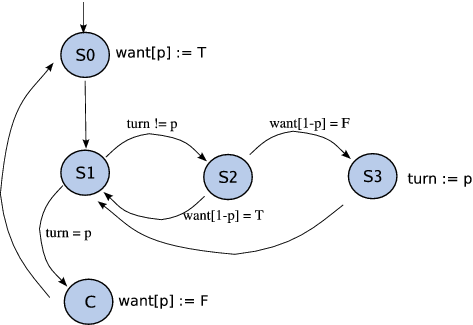
<<もくじ:Formal Verification Memo
次に、Murphi で同じモデルの検証をしてみたいと思います。 Murphi におけるモデルの記述は、Promela の場合とは少し違った感じになります。
(ご注意:前ページの promela モデルは、Basic Spin Manual に書いてあったものなので、 おそらく間違っていないと思いますが、本ページのモデルは、さっき海野が書いたものなので、 嘘っぱちである可能性大です。バグってたり、嘘っぱちだったりする箇所を見つけたら、 おしえてください。 uDiary の方につっこんでもらえるとありがたいです。)
コーディングに先だって、検証対象の状態遷移図を書いてみます。

上図は、先ほどの promela によるコードを見ながら書いたものです。 状態遷移の形にできてしまえば、murphi で記述するのは簡単です。
-- Filename: dek0.m
-- Version: Murphi 3.1
-- Content: Bad Example for mutual exclusion.
type
proc_idx_t: 0..1;
want_t: enum {T, F};
state_t: enum {S0, S1, S2, S3, C};
var turn: proc_idx_t;
var want: Array [ proc_idx_t ] of want_t;
var stat: Array [ proc_idx_t ] of state_t;
procedure goto(p: proc_idx_t; s: state_t);
begin
stat[p] := s;
end;
ruleset p: proc_idx_t do
rule "S0 -> S1 always"
stat[p] = S0
==>
begin
want[p] := T;
goto(p, S1);
end;
rule "S1 -> S2 if other's turn"
stat[p] = S1 & turn != p
==>
begin
goto(p, S2);
end;
rule "S2 -> S3 if another is not wanting"
stat[p] = S2 & want[1-p] = F
==>
begin
goto(p, S3);
end;
rule "S2 -> S1 if another is wanting"
stat[p] = S2 & want[1-p] = T
==>
begin
goto(p, S1);
end;
rule "S3 -> S1 always"
stat[p] = S3
==>
begin
turn := p;
goto(p, S1);
end;
rule "S1 -> C (Critical) if its turn"
stat[p] = S1 & turn = p
==>
begin
goto(p, C);
end;
rule "Critical Session"
stat[p] = C
==>
begin
want[p] := F;
goto(p, S0);
end;
end;
startstate
begin
for p : proc_idx_t do
goto(p, S0);
want[p] := F;
end;
turn := 0;
end;
invariant
!(stat[0] = C & stat[1] = C);
muphi モデルを実行するには、まず mu で murphi モデル (今回のファイル名は dek0.m) をコンパイルして、さらに出来た C++ プログラムを (g++ などで) コンパイルします。
% mu dek0.m
% g++ -I ${Murphi3.1path}/include -o dek0 dek0.C
% ./dek0
This program should be regarded as a DEBUGGING aid, not as a
certifier of correctness.
Call with the -l flag or read the license file for terms
and conditions of use.
Run this program with "-h" for the list of options.
Bugs, questions, and comments should be directed to
"murphi@verify.stanford.edu".
Murphi compiler last modified date: Jan 29 1999
Include files last modified date: Jan 29 1999
==========================================================================
==========================================================================
Murphi Release 3.1
Finite-state Concurrent System Verifier.
Copyright (C) 1992 - 1999 by the Board of Trustees of
Leland Stanford Junior University.
==========================================================================
Protocol: dek0
Algorithm:
Verification by breadth first search.
with symmetry algorithm 3 -- Heuristic Small Memory Normalization
with permutation trial limit 10.
Memory usage:
* The size of each state is 40 bits (rounded up to 8 bytes).
* The memory allocated for the hash table and state queue is
8 Mbytes.
With two words of overhead per state, the maximum size of
the state space is 476219 states.
* Use option "-k" or "-m" to increase this, if necessary.
* Capacity in queue for breadth-first search: 47621 states.
* Change the constant gPercentActiveStates in mu_prolog.inc
to increase this, if necessary.
Warning: No trace will not be printed in the case of protocol errors!
Check the options if you want to have error traces.
==========================================================================
Result:
Invariant "Invariant 0" failed.
State Space Explored:
203 states, 202 rules fired in 0.10s.
Analysis of State Space:
There are rules that are never fired.
If you are running with symmetry, this may be why. Otherwise,
please run this program with "-pr" for the rules information.
やはり、Invariant (不変な表明) 違反が検出されました。
失敗ケースのトレースは、-tv オプション付きで実行することで得られます。
% ./dek0 -tv ... (略) ... Startstate Startstate 0 fired. turn:0 want[0]:F want[1]:F stat[0]:S0 stat[1]:S0 ---------- Rule S0 -> S1 always, p:1 fired. want[1]:T stat[1]:S1 ---------- Rule S1 -> S2 if other's turn, p:1 fired. stat[1]:S2 ---------- Rule S2 -> S3 if another is not wanting, p:1 fired. stat[1]:S3 ---------- Rule S0 -> S1 always, p:0 fired. want[0]:T stat[0]:S1 ---------- Rule S1 -> C (Critical) if its turn, p:0 fired. stat[0]:C ---------- Rule S3 -> S1 always, p:1 fired. turn:1 stat[1]:S1 ---------- Rule S1 -> C (Critical) if its turn, p:1 fired. The last state of the trace (in full) is: turn:1 want[0]:T want[1]:T stat[0]:C stat[1]:C ---------- End of the error trace. ... (略) ...
検出された失敗ケースは、前ページ (Dekker0 by Spin) のモデルで検出されたものと同じですね。 turn != p & want[1-p] = T を確認してから、turn := p の操作の間に、 相手プロセスが割り込んでしまうことで、意図しない動作となってしまっていました。